![]()
IT Strategy
To optimize the value of IT to restaurant firms, it is essential that IT be integrated into strategic planning and management. Such integration is essential regardless of the type or size of the restaurant or the type of ownership—corporate or individual. To date, there has been only limited recognition of IT in the strategic thinking of most restaurateurs. When asked whether their firm’s mission statement had any reference to IT strategic planning; only 10.6% of this year’s survey respondents indicated that their mission statement included a reference to IT. This percentage is little changed from the 2003 percentage (9.0%). Thus, even though it seems that restaurateurs now have a more positive outlook toward the incorporate of IT into their operations, they have not yet considered IT to be part of their strategic planning. (See Figure 3.1)
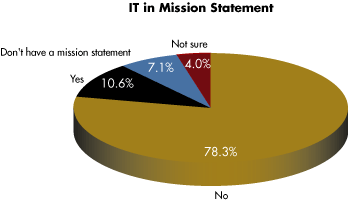
The situation is a bit better in regard to the incorporation of IT into restaurant firms’ general business plans, though there is still much room for improvement. Only about one-fifth of the respondents (21.2%) indicated that technology strategy was highly integrated into their firms’ business plans. Another 60.6% indicated that IT was partially integrated into their firms’ business plans (a combined total of 81.8%.) (See Figure 3.2)
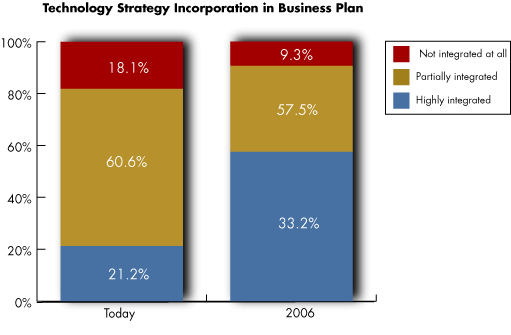
Just as was true in regard to these firms’ mission statements and IT, the situation is little changed from the 2003 survey results which indicated that about 17% of the respondents’ firms had technology strategy highly integrated into their general business plans and about 65% had IT partially integrated (a total of about 82%). The only change seems to be that a few of the firms that had IT partially integrated into their business plans last year now have IT more fully integrated into their plans. Unfortunately, though the remaining 18% of the respondents seem to have made no progress in regard to incorporating IT into their strategic thinking over the past year. There is a window of opportunity here for those restaurant firms who are thinking strategically about IT to gain a competitive edge over other firms that are not using IT strategically.
Although currently IT is not well integrated into restaurant firms’ business plans, the survey respondents were optimistic about the integration of IT into their firm’s strategic planning in the future. When asked to what extent they felt that technology strategy would be incorporated into their firms’ business plans in 2006, 57.5% indicated that they felt it would be highly integrated, and another 33.2% thought that it would be partially integrated (a total of 90.7% of all respondents). While about one-half of those firms who do not currently have any reference to IT in their business plans thought that their firms would have IT incorporated into their plans in at least some way in 3 years, the biggest change anticipated by 2006 is that firms will move from having IT partially integrated into their business plans to having it fully integrated.
Even if technology strategy is inco0rporated into a restaurant firm’s mission statement and/or its business plan, it is also important to consider how IT initiatives are developed, evaluated and implemented within the firm. As has been previously noted, “people issues” were the most frequently noted obstacle to the implementation of IT systems within restaurant firms. How IT initiatives are developed and handled within the firm can potentially have an important impact on “people issues”, or on how well the firm’s employees accept and support the incorporation of IT into their work environment.
When asked where IT decisions were made within their firm, 95% indicated that these decisions were made at the corporate level. Thus, both management and employees at the regional and unit levels of the firms’ operations do not seem to be involved in the IT decision making process. (See Figure 3.3)

Corporate level IT management may well be the persons that are most knowledgeable about the capability of existing and potential IT systems, and they may be the people most able to suggest ways in which IT could be integrated into the overall business strategy. Indeed, 94.2% of the survey respondents indicated that top management should plan an important role with respect to IT strategy. (See Figure 3.4)
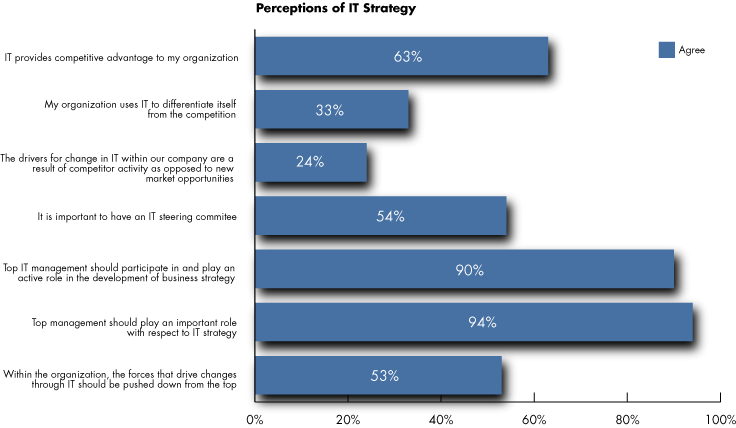
However, top management personnel are not the persons who will actually be “living with” the IT systems on a day to day basis. Even though corporate level personnel can see ways in which IT could enhance the possibility of meeting or exceeding the performance standards established through the strategic planning process, it takes the support and cooperation of personnel at the regional and unit levels in order to actually accomplish those standards. Thus, many restaurant firms have potential opportunities to improve their operational performance through the use of IT, not only by giving IT greater consideration in their mission statements and business plans, but also through the incorporation of regional and unit level personnel into the IT decision making process.
When asked where IT initiatives and IT-drive change are pushed from, the emphasis on the corporate level of management was further emphasized. Forty-two percent of the respondents indicated that, in their firms, IT initiatives were pushed down from the top of the firm. Only 1% indicated that IT initiatives were pushed from the unit level, with 16% indicating that IT initiatives were pushed by middle management or management at the regional level. On a more positive note, though, 41% indicated that IT initiatives were pushed by some combination of management levels; thus persons at the firms’ operational level seem to be more involved in the development and promoting of IT initiatives than they are in the actual decision making regarding IT implementation. (See Figure 3.5)
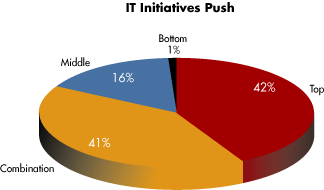
Interestingly, 53.1% of the survey respondents thought that within their organization, the forces that drive changes through IT should be pushed down from the top while 37.2% of the respondents disagreed with this perspective. Thus, there is definitely a feeling among this year’s respondents that managers, other than top level IT managers, should be involved in the IT planning and decision making process. As lower (unit) and middle (regional) management become more involved with the development of IT initiatives, the difficulties with “people issues” as implementation obstacles should decline.
One approach that firms might use to incorporate more persons throughout the different levels of management, as well as from different aspects of corporation operations, into the IT planning and implementation process would be to establish an IT steering committee within the firm. When asked if their firm had an IT steering committee, only 29.2% indicated that their firms had such a committee. (See figure 3.6)
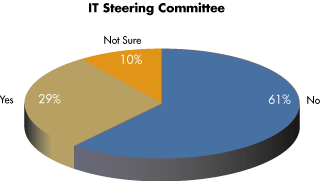
Yet, 54.4% of the 2004 survey respondents and 60.4% of the 2003 survey respondents indicated that they thought that it was important for a restaurant firm to have a steering committee that was responsible for and/or involved with the establishment of the firm’s IT policy. Thus, it seems that although many feel that IT steering committees are important, only about half of those firms have actually implemented such a committee, and little progress has been made over the past year in regard to restaurant firms’ development of IT steering committees. Given the interest in such committees, the development of an IT steering committee is yet another opportunity for many restaurant firms that would like to effectively incorporate IT into their operations and mesh technology strategy with their business plans.
While IT has the potential to enhance a restaurant firm’s competitive edge, it is interesting to note that only 63.3% of the respondents indicated that IT provided a competitive advantage for their organization. However, this percentage represented a slight increase over the 58.2% of the previous year’s respondents who felt that IT gave their firms a competitive edge. One has to wonder why restaurateurs do not feel that the incorporation of IT into their operation can provide them with a competitive advantage. If IT systems will not enhance a restaurant firm’s competitive position, then what is the purpose of implementing such systems?
Further evidence that participants in this year’s survey did not see IT systems as a strategic tool which might give them a competitive advantage was the respondents’ lack of agreement with the statements that “my organization uses IT to differentiate itself from the competition” (only 33.2% agreed), and “the drivers for change in IT within our company are a result of competitor activity as opposed to new market opportunities” (only 24.3% agreed). The percentages of respondents who agreed with these statements are the same as the percentages that agreed with the statements last year. Thus, there has been no apparent change in restaurant firms’ perception of the potential of IT as a strategic tool which they might use to gain a competitive advantage in a highly competitive marketplace.
When considering IT strategy, it is important to know how restaurant firms are spending their IT dollars. Strategic planning for the future is very difficult without knowledge about the present baseline for IT incorporation in the firm’s business. Survey respondents were asked to indicate the percentage of their 2002 budget that was spent on each of 13 possible areas where IT might be utilized. They were also asked to indicate the percentage of their firms’ 2003 budget that was planned for each of these same areas. There was relatively little change in the allocation of these firms’ IT budget from 2002 to 2003. For both years, expenditures for the maintenance and support of existing IT and for hardware/software upgrades accounted for about 44% of the total IT budget. Expenditures for technology infrastructure and technology services, such as training, accounted for another 15% of the IT budget. Thus, a very large portion of restaurant firms’ IT budget is going toward maintaining and upgrading existing systems. (See Figure 3.7)
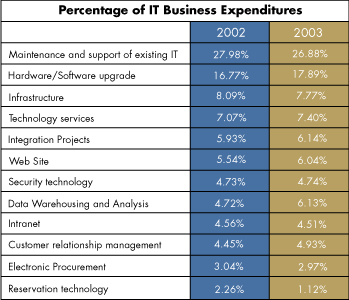
The areas for which restaurant firms spent the smallest portion of their IT budget were for reservation technology (2.26% in 2002; 1.12% in 2003) and electronic procurement (3.04% in 2002; 2.97% in 2003). Not only were these the two areas which accounted for the smallest proportion of the IT budget, but the proportion planned for 2003 declined from the percentage actually spent in 2002. Yet, these are two areas which have the potential to enable a restaurant firm to gain a competitive advantage if adequately developed and incorporated into their strategic business planning.
There were three areas that could be important to restaurant firms’ bottom line in which the proportion of the anticipated 2003 IT expenditures increased somewhat over the actual2002 proportion. These areas were 1) customer relationship management (% of the IT budget rose from 4.45 to 4.93%); 20 website, including management and hosting (% of IT budget rose from 5.54% to 6.04%); and 3) data warehousing and analysis (% of IT budget rose from 4.72% to 6.13%). These changes would seem to indicate that restaurant firms are beginning to recognize the value of IT as a means of enhancing their customer relationships both through their website and through technology that helps them communicate with and otherwise manage their customer relationships. Also, even though they have reduced the proportion of their IT budget directed toward e-commerce, they seem to be increasing the use of IT for their on-site inventory management; thus, they could potentially realize savings in product costs by internally improving their product purchasing and inventory flow.
In summary, the use of IT is not currently incorporated into the mission statement of most restaurant firms. While many firms have now partially integrated technology strategy into their business plans, only a limited number of restaurateurs have technology highly integrated into their business plans. However, it is anticipated that this picture is changing, and that by 2006, the majority of restaurant firms will have technology highly integrated into their business plans.
IT decision making is still highly concentrated at the corporate level, and most IT initiatives are pushed down from the top. However, many firms recognize the potential value of an IT steering committee which would incorporate representatives from all levels of management and from many facets of the firm. However, less than a third of the responding firms have such steering committees. As people issues remain the most frequently indicated obstacle to the incorporation of IT in restaurant firms, the development of IT steering committees which would allow for increased participation of the firm’s employees in the IT initiative and decision process may be an important consideration for firms wanting to capitalize on the potential benefits of IT systems.
Restaurant firms still do not seem to recognize that they may attain a competitive advantage for their firms through the use of IT, possibly because these firms have not considered IT when developing their mission statements and business plans. Thus, the greatest proportion of expenditures in restaurant firms’ IT budgets are allocated to the maintenance and upgrading of existing systems with the smallest proportion of IT budget expenditures going toward new system initiatives that may provide a competitive advantage for the firms.
Technology is changing the way business is done, and the restaurant business is no exception. Today, e-mail addresses are common, and many consumers expect businesses to have web sites. Externally, guests may well soon consider the Internet the way to make reservations for dining at their favorite restaurant.
Internally, electronic transmissions, whether for e-mail or for posting messages on an intranet site, are instantaneous and can be sent and received almost simultaneously. Further, communication is improved since a single message can be transmitted simultaneously to multiple recipients, facilitating the transmission of organizational information to employees. To be competitive today — and certainly in the future, restaurant firms need to be addressing ways to use technology for effective communication, both internally and externally.
Technology is not only being increasingly used for communication, but it is also now incorporated into many operational activities, ranging from inventory management, purchasing, and preparing production estimates to maintaining employee records and payroll files and employee training. IT can enhance data analysis and information reporting; thus, it provides effective support for management decision making as more timely and more accurate information is available. The more complete and timely the information, the more likely it is that management decisions will lead to improved operating performance.
One use of technology which is growing and is expected to continue to grow is the direct linking of restaurants with distributors and/or manufacturers for the purpose of controlling inventory and product flow through the restaurant. Such direct linkage has been shown to be effective in reducing restaurants’ inventory storage costs as fewer square feet of all types of storage space are needed. Product spoilage and theft are also reduced as products arrive at the restaurant very close to the actual time they are needed. Having products arrive at the restaurant shortly before they are needed for production and service reduces the on-premise storage time and makes it easier for management to more closely account for product flow; thus the opportunity for product theft is reduced and products do not age and spoil on storeroom or refrigerator shelves.
The survey respondents were asked to estimate what percentage of their firms’ business transactions with distributors/manufacturers were now conducted over the internet. Forty percent of the respondents indicated that they were not currently doing any business transactions via the internet, and another 39.5% indicated that they were doing 25% of less of their transactions via the internet. However, 16.4% were doing between 26 and 50% of their transactions via the internet and 3.2% were doing more than 76% via the internet. (See Figure 4.1)
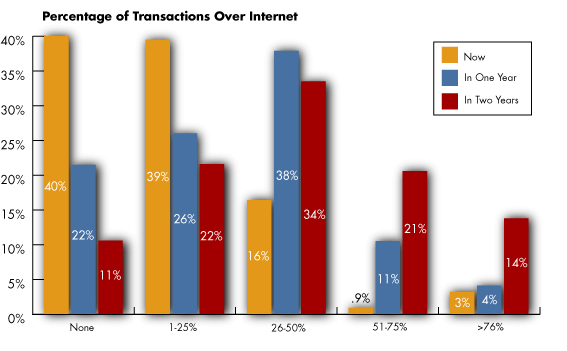
Compared to the survey responses to this question in the 2003 survey, somewhat fewer firms reported that they did no business transactions or did less than 25% of their business transaction over the internet in this year’s survey. However the major change in 2004, compared to the 2003 responses, was the increase in the number of firms doing between 26 and 50% of their business transactions via the internet (increased from 6.6% to 16.4%) and the fact that there were now firms doing more than 76% of their transactions via the internet when there were none reporting that level of internet business transactions in 2003.
When asked their opinions regarding what percentage of their business transactions with distributors/ manufacturers would be conducted over the Internet in one year’s and in two year’s time, the respondents definitely indicated a movement to conducting transactions via the Internet. Within one year, the percentage that thought they would be doing no transactions via the Internet dropped to 21.5%, and the number who thought they would do 25% or less via the internet dropped to 26.0%. The number who thought they would do 51% or more of these transactions via the Internet within the next year increased from a total of 20.5% this year to 52.5%.
The respondents thought that further increases in the use of the Internet for business transactions would occur within two years. The number who estimated that they would not do any transactions with distributors and/or manufacturers dropped to only 10.6%, while the number who thought they would do 51% or more of these transactions via the internet rose to 67.9%. The most dramatic increases estimated were from year one to year two when the percentage of the respondents who thought they would do 51 to 75% of these transactions approximately doubled, going from 10.5% in year one to 20.6% in year two. Also the number of respondents who estimated that they would do more than 76% of these transactions via the internet rose from 4.1% in year one to more than three times that proportion in year two (13.8%).
Thus, it seems clear that restaurant firms are rapidly moving toward the incorporation of e-commerce into their operational management practices. Firms that resist the use of technology for this purpose may find that their competitive position declines within the next few years as they are unable to match the inventory cost reductions that are realized by the firms that do incorporate e-commerce as a management tool and conduct their business transactions with their distributors and/or manufacturers via the internet.
As restaurant firms move toward increasing incorporation of IT into their operations and management, it is interesting to consider what the forces, or drivers, are that are encouraging restaurateurs movement toward IT. The survey respondents were given a listing of several possible drivers and were asked to indicate which one, if any in the list, was the most important force or driver for their firm. More than half of the respondents (51.9%) indicated that productivity or efficiency was the force driving their firm toward increased incorporation of IT into their operations. Other important forces included the development of cost-saving measures (selected by 16.4% of the respondents) and enhanced guest service, recognition, and/or loyalty (selected by 15%). (See Figure 4.2)
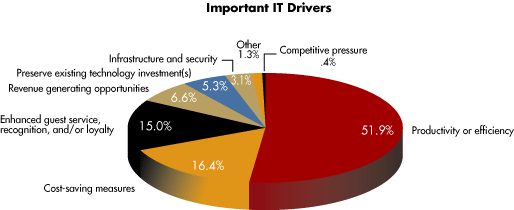
Interestingly, the least important force driving restaurant firms to the incorporation of IT was competitive pressure (selected by only 0.4% of the respondents). The low level of recognition of competitive pressure as a driving force for IT incorporation into restaurant firms has been noted previously in Section 3 of this report. Since IT systems offer many possibilities for restaurant firms to increase their competitive advantage and since the restaurant industry is very highly competitive, one has to wonder why these firms place so little emphasis on competitive pressure and the ability to gain a competitive edge through IT applications. As noted in Section 3 of this report, the lack of consideration of the use of IT to enhance a restaurant firm’s competitive advantage may also be a reflection of many restaurant firms, to date, to incorporate IT into their strategic planning.
What are some future directions that restaurant firms might take in regard to IT? One area for which restaurateurs have given only limited consideration in regard to IT is that of human resources management and training. Yet, labor is generally the largest cost for any restaurant firm, and it is the firm’s employees that are responsible for both product quality and service, two intangible factors essential to maintaining and increasing guest numbers for the firm.
How might IT be utilized in the future to aid restaurant firms in their management of their human resources? Most firms are already applying IT to tasks such as payroll, and many have automated time clocks. Some also use technology to project optimum schedule plans based on the history of guest flow. However, there has been only very limited application of IT to one of the most challenging problems faced by restaurateurs — that of employee training. IT offers great potential to restaurateurs for enhanced employee training. Traditionally, employee training has been done by having experienced employees train new employees in their positions. That training may or may not be well done; it may or may not actually reflect the policies and procedures specified by the firm. It is quite likely not consistent from employee to employee. However, if the training was done through the use of IT, all new employees could be consistently trained in the desired policies and procedures and the skills associated with their tasks. Training could also be done in multiple languages, helping restaurant firms cope with the language problems inherent in today’s multi-cultural staffs. Training time could also be more efficiently managed as both new employees and old employees participating in refresher training could move through the training program at their own pace, and their competency level in the desired skills could be individually assessed.
Restaurateurs may ask if their employees would accept the use of IT for their training. It must be remembered that the restaurant industry work force is generally a young workforce composed of persons who have grown up with computer technology and are very comfortable with all aspects of IT. Thus, it seems likely that restaurant firms’ employees would respond well to the application of IT to their training. Also, there is a trend toward the incorporation of IT in all levels and types of education — from elementary schools through college; from vocational skills through the most sophisticated graduate work. Thus, the technology is available, and new developments are always on the horizon, for the application of IT to workforce training.
In summary, IT is changing the way the restaurant business is done. Not only are customers expecting to find information about a restaurant on the Internet, but they are also relying on the Internet and email as a means of communicating with restaurants for reservations. Indeed IT is now essential as the means of communication for restaurant firms, both internally and externally. Externally, one of the most significant changes that are occurring in restaurant operations is the advent of e-commerce or restaurants communicating directly with their distributors and/or manufacturers via the Internet. E-commerce is enabling restaurateurs to enhance their inventory control, reduce the level of inventory that must be maintain on the restaurant’s premise, and enhance their control of product spoilage and theft. Within the next two years, it is anticipated that almost all restaurants will be doing at least some of their supplier transactions via the Internet, and an increasing number of firms will be doing the majority of their transactions using IT.
The next “frontier” for restaurants in the use of IT may well be the management of their human capital — the management and training of their employees. There is great potential for the incorporation of IT into employee training activities, thus improving employee skills while saving training time on the job. Improved employee training should not only help reduce labor costs by potentially reducing labor turnover (well trained employees tend to have increased job satisfaction and are less likely to leave their jobs), but should also improve the quality of service restaurants are able to provide their guests, potentially increasing guest satisfaction. Thus, the application of IT to human capital management may both reduce labor costs and increase the restaurant’s revenue stream with resulting enhancement of the restaurant’s bottom line.
Conclusion
This study is the sixth annual foodservice technology study conducted by Hospitality Technology. The trend toward greater IT expenditures among restaurant firms noted last year is continuing at an increasing rate, and is expected to do so over the next three years. The number of restaurateurs spending 1% or less of their revenue on IT continues to drop significantly, dropping to only 40.3% of the respondents this year compared to 60.5% last year, while the number of restaurateurs spending 3% or more of their revenue on IT continues to grow. Contrary to popular belief, it is not just the large restaurant firms that are investing in IT. The smaller restaurant firms are also investing in IT at a rate equal to or exceeding that of the larger firms with 17% of these smaller firms expecting to invest 5% or more of their revenue in IT within the next 3 years.
However, although IT expenditures have increased, restaurant firms have made little progress in regard to recognizing the important of IT in their mission statements or incorporating IT into their strategic business planning. On a more positive note, though, 57.5% of this year’s survey respondents felt that IT would be highly integrated into their strategic business planning within 3 years and an additional 33.2% felt it would be at least partially integrated by that time.
The majority of IT initiatives and decisions still continue to be made at the top management level. Even though more than half of the respondents felt that it was important to have an IT steering committee, less than a third of the respondents indicated that their firms had such a committee. As “people issues” are recognized as the primary obstacle to effective implementation of IT systems, the development of an IT steering committee could be a tactic that restaurant firms might employ to both integrate their IT decision making more with their overall business strategy and help alleviate some of the “people issues” by incorporating more persons into the IT decision process.
Restaurant firms are also changing the way in which they evaluate IT initiatives. They are less inclined to use structured assessment procedures, such as they might use for other capital investments, but are focusing more on developing pilot projects and collecting pre- and post-implementation data for analysis as a means of evaluating the success of an IT system. Criteria for IT system success are focused more on operational and customer parameters, many of which are currently intangible measures, rather than on financial measures, such as stock values.
Restaurateurs are becoming more willing to be innovators/leaders from both a business and an IT perspective than they were in the past. This year, 65.9% of the respondents indicated that their firm preferred to be an innovator/leader, compared to only 42.9% last year. From an IT perspective, 30.5% indicated that their firm preferred to be an innovator/leader, compared to 17.6% last year. Perhaps restaurateurs are becoming more comfortable with IT, and as a result, they are more willing to be innovators/leaders in regard to IT systems. However, it is possible that the continuing lag in the economy is causing restaurateurs to think more aggressively than in the past; causing them to recognize that it is the innovator/leader who may be able to capitalize on a new competitive strategy even though there is risk associated with being an innovator or market leader.
It is notable that restaurant firms still do not seem to see IT as a tool which has the potential to help them gain a competitive edge. The most important factors that seem to be driving IT implementation are productivity and efficiency and cost saving measures, i.e. operational activities. While enhanced guest service, recognition, and/or loyalty is the third most frequently indicated factor driving IT systems development and could be considered a factor impacting the competitive advantage of a restaurant, competitive pressure is the factor least indicated as a driver for IT implementation. The low level of recognition of IT as a strategic component of restaurant firms’ business plans may play a role here as firms may just not yet be thinking of the “big picture” regarding IT implementation; thus, they do not see a relationship yet between IT and their ability to gain a “competitive edge”. IT, properly utilized, can be a very effective strategic tool for restaurant firms, and it is hoped that firms will soon give greater consideration to IT in their strategic planning.
Technology is changing the way that restaurants do business. Changes range from increased communication, both internally and externally to increased incorporation of e-commerce as the approach for working with product distributors/manufacturers. Although restaurants have slightly decreased the proportion of the IT budget that they are spending on e-commerce, Internet communication with distributors/manufacturers is here to stay and will become increasingly more prevalent over the next 1 to 2 years. E-commerce enables a restaurateur to have better control of his product flow and reduce the costs of product storage and theft.
An area of potential IT application that seems to be as yet largely untapped by the restaurant industry is that of using IT to facilitate the management of human capital — the people that are the heart of the restaurant industry. While IT systems have long been applied to facilitate some functions related to human resources, such as payroll, little use has been made of technology for the purpose of training and education employees. As “people costs” are the largest expense item for any restaurateur, the incorporation of IT into employee training offers substantial potential for enhanced management of human resource dollars as well as for enhancement of the service provided to the restaurant’s guests — and, hopefully, for increasing the revenue stream from those guests.
Although technology is becoming more widespread among restaurant firms, there are still ample opportunities for increased usage of IT by these firms. It may well be that the firms that are best able to incorporate a full range of IT options that are compatible with their missions and strategic plans will be the firms that are most able to be successful in this highly competitive field in the future.